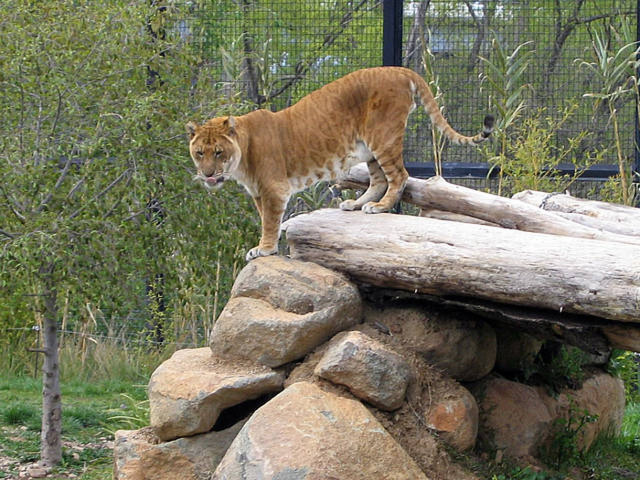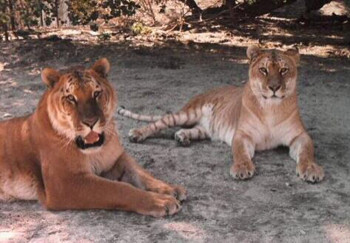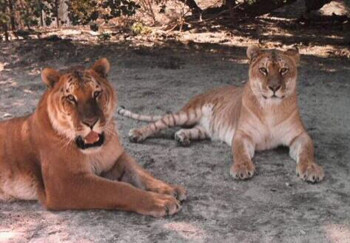Zonkey, Wholphin, Liger, Tigon: Fascinating Animal Hybrids [PHOTOS]

In Florence, the love of a persistent male zebra and a female donkey culminated in the birth of a hybrid “zonkey” last week. The young crossbreed, named Ippo, is reportedly the first zebra-donkey hybrid born in Italy.
Zonkeys aren’t the only hybrid possible with a zebra. The stripey creatures are closely related to horses and donkeys – they all belong to the same genus, Equus. While two equine species may be compatible enough to breed, the offspring, like a mule, is usually sterile.
Usually these kinds of zebra-other equine hybrids (also known as zebroids) are fathered by zebras, but in rare cases the sire can be a horse or a donkey. When a male horse breeds with a female zebra, that’s known as a “hebra.” Even rarer is when a male donkey pairs with a female zebra; that foal is a “donkra.”
Zonkeys and zorses aren’t the only fascinating hybrids found in nature. The liger, a product of a lion father and a tiger mother, isn’t just a joke from “Napoleon Dynamite” – it’s real! The liger is almost always a product of human intervention, since African lions and South Asian tigers would never come into contact in the wild.

A tigon, meanwhile, is the offspring of a male tiger and a lioness. A tigon’s appearance can vary – he or she will sometimes have spots, like lion cubs, along with stripes from its father. A male tigon usually won’t develop a full, flowing mane but will instead retain a bit of a ruff.

Though tigons were previously thought to be sterile hybrids, as with ligers, in rare cases they can produce progeny. This second-generation hybrid is called a li-tigon if the tigon mates with a lion, and a ti-tigon if the tigon couples with a tiger. One ti-tigon, Nathaniel, was born at the Shambala Preserve in California. The story of Nathaniel's unlikely conception mirrors the story behind other big-cat hybrids: Keepers had assumed Nathaniel’s tigon mother was sterile, so they figured it was safe to house her with a male Siberian tiger.
The fragility of first- and second-generation lion-tiger hybrids has been a cause for concern. In 2004, the Taipei Times reported that Indian scientists were sterilizing crossbreeds in zoos in a “controlled extinction.” Ligers and tigons had no conservation value to justify the cost of dealing with their extensive health issues, the rationale went.

Other big-cat crosses are possible as well: Both jaglions (jaguar-lion hybrid) and jagupards (jaguar-leopards) have been bred in zoos. There’s also a cottage industry focused on breeding domestic cats with wild relatives, producing exotic-looking hybrids that command high prices from prospective owners. One of the more common “wild” appearing cat crosses is the Bengal, a mix of the domestic cat and an Asian leopard cat. The New Yorker covered the wild cat breeding trend back in May.

Bottlenose dolphins and false killer whales (a cetacean that looks like a killer whale but actually isn't) might seem oceans apart, but they’re related enough to occasionally produce a mixed offspring known as a wholphin. The only known living wholphin is Kekaimalu, who in 2004 gave birth to a calf sired by a male bottlenose dolphin (a do-wholphin?). Both mother and child live at Sea Life Park in Hawaii.
These striking hybrids will probably never be more than beautiful curiosities, because their infertility dooms them to be an evolutionary dead end. But hybridization is happening in nature all the time; there may have even been some cross-breeding between Neanderthals and ancient humans – if true, perhaps would we would do better to call ourselves humanderthals. Some of the genes of the Neanderthal may have been key to ancient humans' adapting to the harsh climates they faced when they left Africa.
“Because species hybrids create new combinations of genes, it is possible that some combinations might enable hybrids to adapt to conditions in which neither parent may fare as well,” University of Wisconsin geneticist Sean Caroll wrote in the New York Times in 2010.
© Copyright IBTimes 2024. All rights reserved.





















